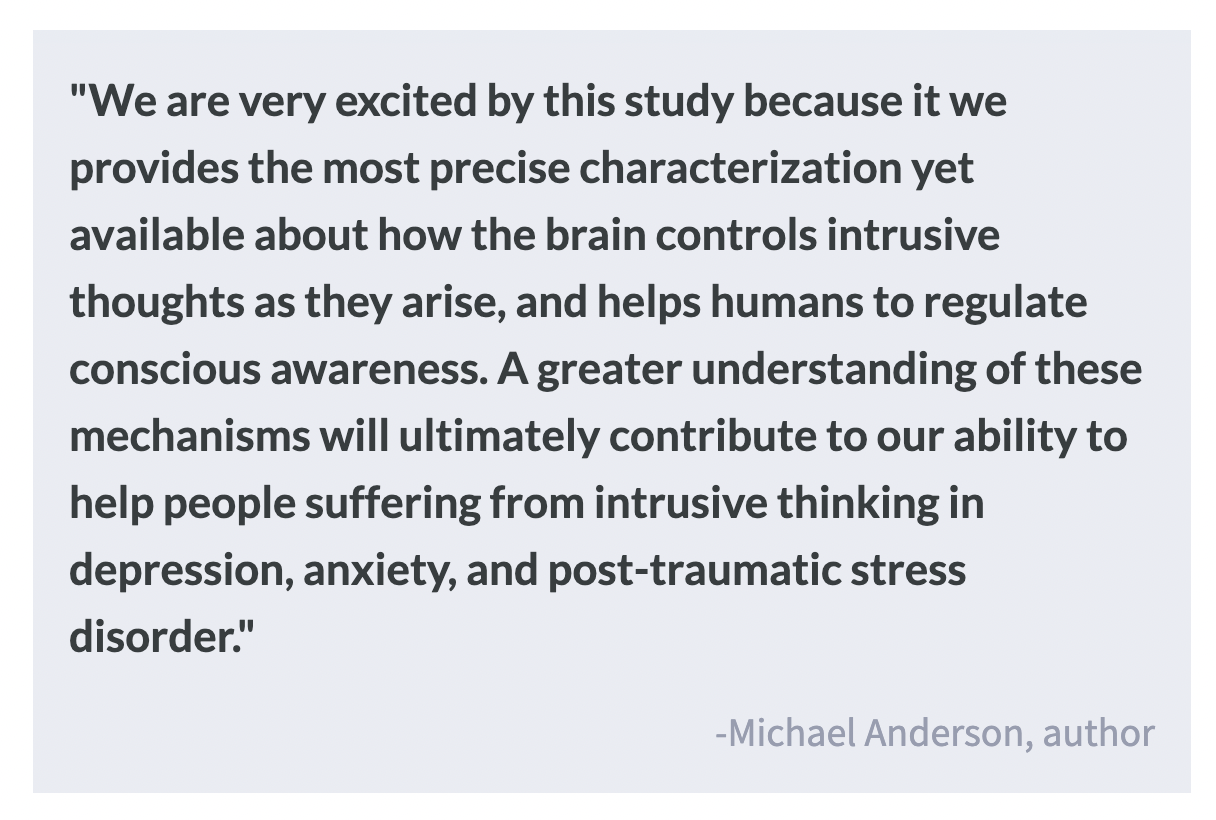The Anterior Cingulate Cortex Signals the Need to Control Intrusive Thoughts
Post by Leanna Kalinowski
The takeaway
The human brain has evolved mechanisms that enable it to suppress unwanted memories from coming to mind. This study identified a crucial role for the anterior cingulate cortex in detecting and responding to these intrusive thoughts.
What's the science?
Recalling an unwanted memory can be distressing, but luckily, the human brain has adapted to be able to prevent such memories from coming to mind. When such memories intrude, the brain detects a need for control, which engages the prefrontal cortex to inhibit activity in the hippocampus, which then stops retrieval of the unwanted memory. However, it is unknown which brain region is responsible for detecting and coordinating a response to this need for control. During non-memory contexts (e.g., moments of surprise), many scientists believe that the anterior cingulate cortex (ACC) coordinates a need for control, but this region’s role in inhibiting unwanted memories has not yet been examined. This week in the Journal of Neuroscience, Crespo García and colleagues tested the role of the ACC in processing and preventing unwanted memories.
How did they do it?
Twenty-four participants first underwent the “study phase”. Here, they were tasked with studying 64 pairs of words that were shown side-by-side on a computer screen for 5 seconds each. After being shown each word pair, they were given one word from each pair and were asked to recall its associated word. Each participant repeated the study phase until they were able to correctly recall at least 50% of the words, and the words that they recalled were then used in the subsequent phase.
Participants next underwent the “Think, No-Think (TNT) phase”. This phase consisted of six blocks, each containing 80 words. During “Think” trials, a word appeared with a green frame around it, and participants were asked to recall and think about its associated word. During “No-Think” trials, a word appeared with a red frame around it, and participants were asked to pay full attention to the word on the screen but to actively prevent the associated word from entering their memory. During this phase, participants underwent functional magnetic resonance imaging (fMRI) scans and electroencephalography (EEG) recordings to measure brain activity.
Finally, they performed two types of tests: a same probe test, in which they were shown a word and were asked to say out loud its associated word, and an independent probe test, where they were given a category and were asked to say out loud any word from the original list that was within this category (e.g., category = “vehicle”).
What did they find?
From the EEG recordings, the researchers found that theta signals in the ACC play a role in detecting a need for memory control, particularly during two key time points. The first time point was early in the “No-Think” trials, which suggests a proactive control prior to the unwanted memory. This signal was associated with reduced activity (via fMRI) in the hippocampus, ACC, and prefrontal cortex, suggesting that the suppression of memory early on led to a decrease in demand for activity from these brain regions. The second time point was later into the “No-Think” trial, which suggests a reactive response following the successful intrusion of the unwanted memories. This was associated with increased communication from the ACC, to the prefrontal cortex, to the hippocampus, suggesting that these brain regions work together to facilitate forgetting of the unwanted memory.
What's the impact?
This study showed that the ACC not only detects the need for memory control but also responds proactively and reactively to unwanted memories by triggering other brain regions that are necessary for memory processing. During instances where unwanted memories still emerge, the ACC communicates with the prefrontal cortex, and these regions then work together to inhibit the hippocampus and suppress the intrusive thought.


